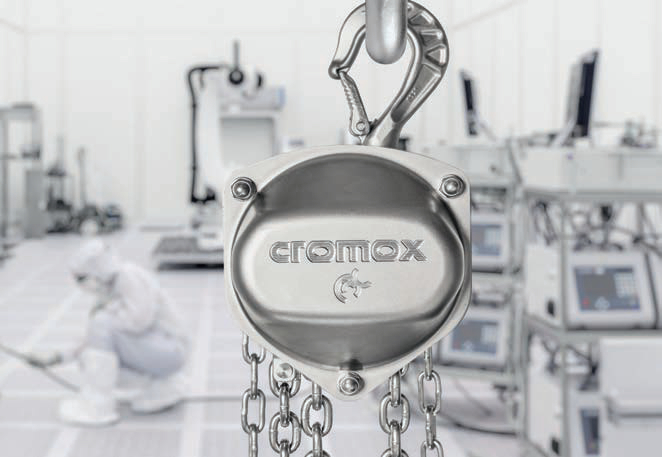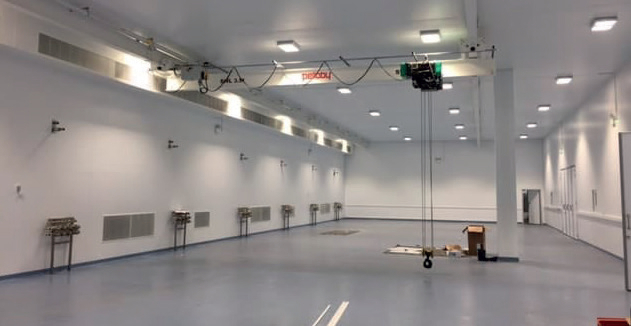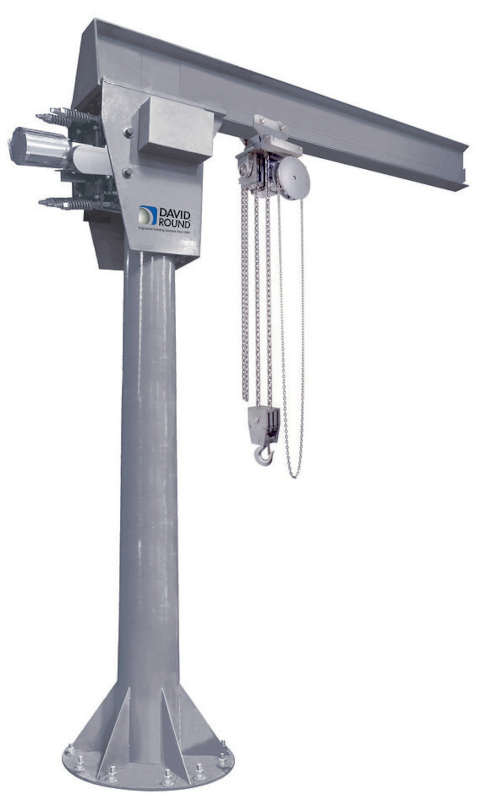Cleaning up
30 November 2021Clean room hoists are in high demand, buoyed by the ongoing COVID-19 pandemic and the continuing semiconductor chip shortage. Mike Straus reports on the complexities of serving this unique sector.
The clean room applications market has been on a tear, as reported by Dublin, Ireland-based Research and Markets ‘Global Cleanroom Technology Market Report 2020-2030’. It states that the global clean room technology industry will post 7.2% compound annual growth over the next four years, reaching a valuation of $7.3 billion USD by 2025. The COVID-19 pandemic and the global semiconductor shortage have caused demand for computer chips, vaccines, and pharmaceuticals to spike, prompting manufacturers in these industries to boost spending on capacity-expanding initiatives. The Harvard Business Review reported in February 2021 that the Taiwan Semiconductor Manufacturing Company, the world’s largest manufacturer of semiconductors, increased its budget for capital projects to $28bn.
Meanwhile, continued investment in the aerospace industry is driving a need for clean room equipment for performing experiments and building new tools for use in space. Clean room applications are an area of significant demand, making this sector profitable for hoist companies that can meet its unique requirements.
Scott Zinter, president, Zinter Handling in Saratoga Springs, New York, USA, says clean room handling equipment is the fastest-growing segment of Zinter Handling’s business. The company has completed at least one project that directly supported the production of a COVID-19 vaccine. Zinter says that in sensitive industries where clean rooms are regularly used, all material handling equipment must meet strict requirements.
“All the moving parts of our product are precision-machined,” he says. “Everything has to fit hand-in-glove. Any type of misalignment or poor interaction between components results in particulates, which is why everything needs to be a hundred times more precise than a standard piece of industrial equipment.”
Zinter Handling produces overhead crane systems, jib and gantry cranes, and material handling equipment for both industrial and clean room use. Zinter says that the business’ clean room division typically has significantly longer project cycles than the industrial division. Project timelines, he says, last a great deal longer because every piece of equipment must be perfectly precise. Working in a clean room setting also involves specific protocols that all personnel are required to follow.
“If it’s an operational clean room, there are numerous protocols to follow in order to enter, work in, and exit the room,” Zinter explains. “You have to perform your tasks while wearing a protective white suit. Masks, safety glasses, rubber boots; it’s not a comfortable working environment. Staff also need to be trained in the proper process and protocol for working in a clean room environment.”
Adding to the complexity of clean room projects is the fact that most clean room installations demand almost entirely custom work. Zinter Handling regularly invents new pieces of machinery to meet specific applications, as pre-existing designs often fail to meet clean room requirements. Zinter says some companies may try to pass off standard industrial equipment as clean room equipment by painting it white. He explains the key to rooting out bad actors in this sector is insisting on seeing documentation:
“There are plenty of people in the marketplace who call their equipment clean, but can’t provide any documentation that it is clean. We can provide documentation that proves our product is actually clean.”
Clean room hoists may be involved in a variety of processes that could increase the risk of particulates if the hoist isn’t designed or installed correctly. Matt Downing, director of sales and marketing for David Round Company in Streetsboro, Ohio, USA, notes that production hoists in clean rooms are typically used for moving product from one production station to another. Downing says designing hoists for these applications involves a significant amount of engineering work to customize the equipment for individual customer requirements.
“The hoists are usually required to be entirely stainless-steel construction,” he notes. “Sometimes there are polishing requirements, which we can do if requested. Sometimes there are explosion-proof requirements for motors, brakes, and controls. We custom engineer for each customer’s needs.”
David Round Company has supplied clean room hoists and cranes, as well as custom-engineered material handling solutions, to pharmaceutical companies like Pfizer, Merck, and GlaxoSmithKline. These companies, and other clients in the clean room/pharmaceutical industry, typically require hoists to have high-quality finishes that can meet particular specifications.
Clean room applications also tend to have specific requirements regarding the types of cleaning solutions, lubricants, and other chemicals in use. Hoists are usually required to be made with entirely stainless-steel construction. David Round Company’s trademarked Lab-Lift, for instance, is a fully enclosed stainless steel strap hoist designed for use in clean rooms. The Lab- Lift’s mechanical components are sealed inside a stainless-steel enclosure, with the only external component being a stainless-steel swivel hook on a urethane-coated Kevlar strap. The Lab-Lift features smooth ground welds, flush mounted faces, and plugged fasteners, all of which work to reduce possible avenues of contamination.
Downing says in the United States, there are no official regulatory standards that hoist equipment must meet to be considered suitable for clean room use, apart from lubricants and paint finishes. The US Food and Drug Administration has approved certain paint finishes, and the government requires all oils and lubricants to be food-grade; otherwise, there is no universal government-imposed standard for what constitutes a clean room hoist. This means the quality and safety managers at the client company are responsible for establishing their own requirements for hoist design and use.
“The first challenge with custom-engineered equipment, apart from ensuring quality and safety requirements are front and centre, is overcoming a price objection from the customer,” Downing says. “It’s a challenge because we bid on a lot of projects in the food and pharmaceutical markets that require both spark-resistant and corrosion-resistant equipment. But ultimately, if quality and safety are involved, they take precedent over price.”
VOLUNTARY PRODUCTION STANDARDS
While there is no universal standard that clean room hoist equipment is required to meet by any particular law, the International Organization for Standardization in Geneva, Switzerland, has a list of voluntary standards that could include clean room hoists depending on the application in question. Gayle McCann, marketing communications and project manager for William Hackett Lifting Products in Alnwick, Northumberland, UK, says clean room hoists are typically covered by ISO 14644, which specifies air purity classifications depending on various levels of airborne particle concentration, and other related standards. However, the end-user application will influence which ISO standard applies.
“The standards are typically divided into live science and chemical,” McCann says. “Live science would include particle emission, chemical resistance, bio growth, cleanability, antibacterial, and hydrogen peroxide reactivity. Chemical would include particle emission and degassing.”
The clean rooms themselves are also subject to ISO classification, with clean room levels ranging from ISO 1 to ISO 9. According to Pegasus Clean, a San Diego, CA, USA cleaning services company that serves the clean room industry, ISO class 1 clean rooms must have a room air exchange rate of 500 to 750 changes per hour. These clean rooms must also test below 12 particles per cubic metre. ISO 1 is the strictest ISO standard of cleanliness for clean rooms; ISO 1 clean rooms are most often used in the life sciences, nanotechnology, and aerospace industries. The European Space Agency’s microbiology laboratory in Noordwijk, The Netherlands, houses an ISO 1 clean room that is used for Planetary Protection procedures; these procedures are designed to prevent cross-contamination between planets when astronauts take organic matter onboard a space flight or return to earth with organic material samples.
McCann notes that while clean room equipment has traditionally been used in the pharmaceutical and electronics industries, the COVID-19 pandemic has prompted other industries to adopt clean rooms as well:
“Due to the growing need for safe bulk manufacturing of foodstuffs, beverages, and cosmetics, many process steps including injection moulding of preforms and plastic packages are conducted in lower level clean rooms.”
The semiconductor industry is driving much of the demand for new clean rooms. Thomas Christensen, VP, Design for Emmett, Idaho, USA-based Syclone ATTCO, says semiconductor manufacturers are the source of most of the demand for Syclone ATTCO’s clean room solutions.
“Most of the other industries are repair and maintenance environments,” Christensen says. “The equipment, whether it’s the robots or the semiconductor equipment, is very well engineered. It does its job perfectly without fail, and, for the most part, without human intervention.”
Despite precise engineering, though, all equipment must eventually be replaced. Christensen says that in clean rooms, the production machines are typically replaced once every five to seven years. This can often require a hoist solution that enables engineers and technicians to access a location in the clean room they didn’t anticipate needing to access. Clean room hoist solutions are often constrained by floor space and room configuration, which demands innovative solutions. Syclone ATTCO’s products solve this problem in a creative manner.
“Our equipment is mobile,” Christensen says. “We focus specifically on mobile equipment so the customer doesn’t need to affix the hoist to the floor; they can get the equipment into the clean room, use it as needed, and then push it out and store it. Space is at a premium in clean rooms, so the focus is on taking up the least amount of floor space as possible while maximizing reach.”
A new clean room hoist design may need to account for a variety of factors like nearby stools, handrails, floor mats, and other ergonomic devices. Given that clean room floorplans tend to vary, developing a clean room hoist often involves creating a custom base and managing lines, hoses, and wires. Christensen says that if a hoist cannot be easily stored when not in use, then it must provide some kind of other useful functionality beyond its primary purpose.
Syclone ATTCO has recently seen an increase in demand for maintenance hoists as clients attempt to extend equipment lifecycles. Some of Syclone ATTCO’s clients also have new clean room builds underway that may require hoist equipment in the near future. Throughout 2021, several clients have sought to customize their Skyhook devices for clean room use, which has also prompted new equipment orders.
Some of the emerging design trends in this sector involve preventing damage to equipment and harm to operators. Syclone ATTCO has developed torque limiters for clean room lifting devices that are designed to prevent equipment damage.
Christensen says Syclone ATTCO has recently developed a variety of technological solutions to prepare for upcoming new installations:
“Our goal is to keep things as simple as possible. We design our equipment to avoid buildup of electrostatic charge. Depending on the application, we may put in an underhook device. But this market is almost 90% custom work.”
However, designing a new solution that suits a clean room may not be the most challenging portion of a project. The COVID-19 pandemic may have caused a spike in demand for clean room equipment, but it has also forced several changes in the way projects get done.
Christensen says Syclone ATTCO has had to modify the company’s communications and planning strategies to meet social distancing constraints.
“We aren’t able to get on-site as easily,” he explains. “I’ve actually seen an improvement when it comes to customer communication, because they’re using video technology a lot more and allowing us to get information remotely.”
CONTROLLING PARTICULATE GENERATION
While other design considerations like ergonomics, floor space, and utility are important, all clean room hoists must meet one basic minimum requirement: They must generate as little particulate matter as possible.
Jeffrey Thornton, senior mechanical engineer for Beaverton, Oregon, USA-based Allied Power Products Inc. (APPI), says designing hoists in a manner that limits particulate generation is a multifaceted and challenging process. However, new products are coming out that are enabling cleaner designs.
“It’s all about the minimization and containment of particulate,” Thornton says. “The choice of coatings and surface preparation goes far beyond simply being smooth and wipe-able, and in many cases, the overall finish must be polished. With this in mind, and due to the need across many industries, motor manufacturers are making products that work very well in a clean room setting.”
These new clean room motors, Thornton explains, boast a variety of features that make them ideal for use in clean room environments. In addition to stainless steel offerings, aluminium gearmotors are now available via special order, and at least one manufacturer provides surface conversion coating. This type of coating is applied with a proprietary process that is typically used for improving corrosion resistance; it also works well in clean room applications, as it eliminates the off-gassing associated with traditional paints, coatings, and finishes.
“Brushless motors, gearcase breather valves that provide submicron filtration, breather valves, and then there are the coated ropes and straps,” Thornton says. “There isn’t much in the way of high-tech equipment that benefits clean rooms, but for a number of reasons, the equipment that’s on the market is getting better across the board.”
Eric Peterson, general manager at APPI, says there are several application-specific methods for reducing particulates. One APPI client in the semiconductor industry uses a nylon-coated galvanized wire rope assembly with an ultra-high molecular weight polyethylene (UHMWPE) wear plate that can be easily removed and replaced. In a non-clean room environment where particulate generation was not a concern, APPI would typically provide a tension plate or roller made from steel or stainless steel. The substitution of UHMWPE material is one example of the extensive custom work that occurs in clean room applications.
“Everything (in clean rooms) is application-based and dependent on customer requirements,” Peterson says. “Our bread and butter is when customers bring an application requirement to us and we determine how to meet it.”
These sorts of projects appear to be in high demand. APPI has recently seen an uptick in clean room equipment inquiries, and one long-term client doubled its orders in the last year.
However, despite the high rate of custom work, some solutions work for multiple clean room installations. Peterson says APPI will often provide a design solution consisting of a clean room-safe changeof- direction sheave within the clean room, which enables the wire rope or strap to exit the clean room to the hoist. This approach enables APPI to provide a solution that positions the hoist outside the clean room while keeping the control panel and hook inside the clean room.
Manipulating the environment and assembly itself is a creative and effective means of meeting clean room requirements. Thornton says that sometimes, there are workarounds that enable the use of an otherwise problematic material.
“Coatings on wire ropes and strap webbing still generate particulate, but at a significantly reduced rate,” he says. “In addition, they’re easier to clean. We’ve had a lot of cases where there isn’t necessarily a solution that can be met by altering the materials used. In these cases, there’s the option of putting the hoist in a negative pressure containment area that is fitted with HEPA filtration.”
The COVID-19 pandemic and the global semiconductor shortage have dramatically increased demand for clean rooms and clean room equipment. Lifting solutions for this market are highly specialized, high-value, custom-engineered products that must meet specific requirements. Every aspect of installation and maintenance work must be carefully planned well in advance, including providing staff with clean room suits, training staff on proper clean room protocols, and creating mitigation measures for preventing particulate contamination. However, the sensitive nature of clean room environments means suppliers that can demonstrate expertise in this niche are likely to find a steady stream of projects. The varied nature of end-use subsectors like pharmaceutical development, semiconductor manufacturing, and aerospace engineering also means that suppliers can diversify their portfolio of clean room projects to access multiple revenue streams and mitigate risks. Companies that can guarantee extreme attention to detail and strict internal quality standards will find the clean room industry a welcoming one.
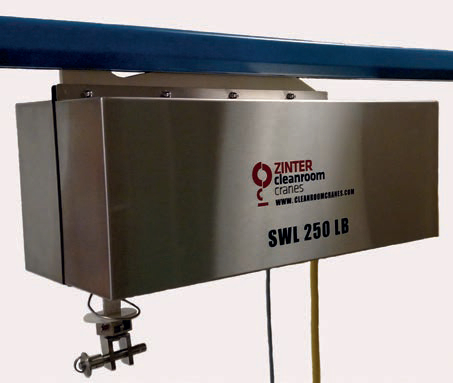 A Zinter Handling E Hoist designed for a pharmaceutical company in Mexico. The hoist is rated for an ISO 5 environment and was installed in 2018.
A Zinter Handling E Hoist designed for a pharmaceutical company in Mexico. The hoist is rated for an ISO 5 environment and was installed in 2018.
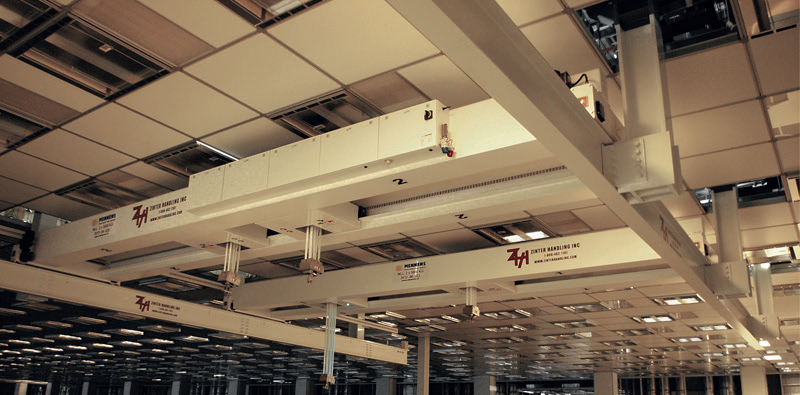 Two 10-ton Zinter Handling overhead bridge cranes in use at the State University of New York Polytechnic Institute. SUNY Poly’s College of Nanoscale Science and Engineering uses these cranes to service an EUV research tool.
Two 10-ton Zinter Handling overhead bridge cranes in use at the State University of New York Polytechnic Institute. SUNY Poly’s College of Nanoscale Science and Engineering uses these cranes to service an EUV research tool.
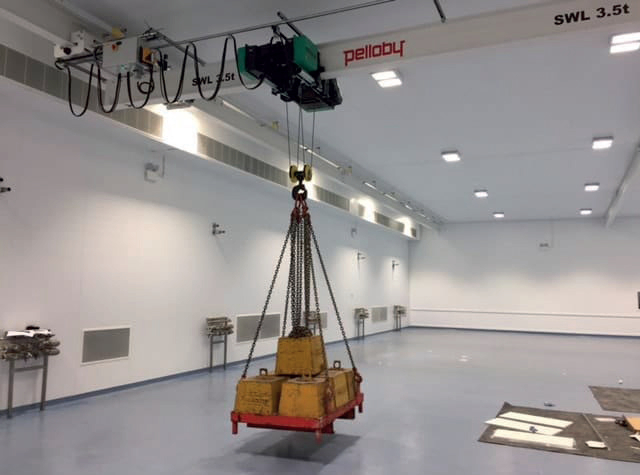 The Pelloby hoist was designed to maximize available lift height using low-headroom construction and an underslung design.
The Pelloby hoist was designed to maximize available lift height using low-headroom construction and an underslung design.
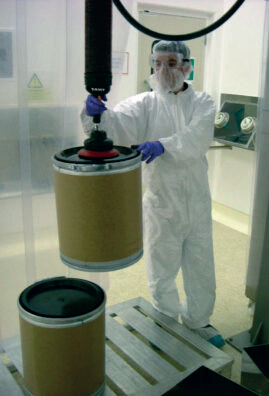 A TAWI VacuCobra stainless steel high-frequency vacuum lifter designed for use in pharmaceutical clean rooms
A TAWI VacuCobra stainless steel high-frequency vacuum lifter designed for use in pharmaceutical clean rooms
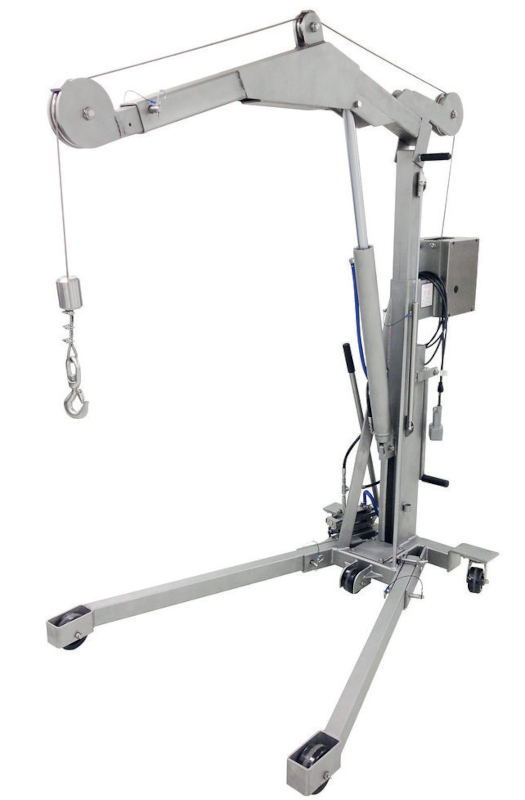 A David Round Co. stainless steel floor crane with powered stainless steel winch designed for clean room use.
A David Round Co. stainless steel floor crane with powered stainless steel winch designed for clean room use.
